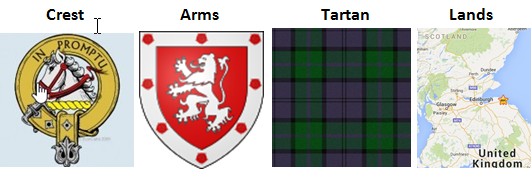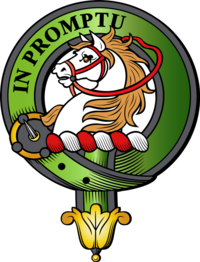Clan Dunbar

http://en.wikipedia.org/wiki/Clan_Dunbar / Wikipedia Clan Dunbar
http://www.clandunbar.com/history.htm /Clan Dunbar History
History of the Clan
The chiefs of Clan Dunbar are of ancient Celtic origin. The town and port of Dunbar have featured prominently in Scottish history on various occasions.
Gospatric, Earl of Northumbria received from Malcolm III of Scotland, the lands of Dunbar as well as other parts of Lothian. In 1128 Gospatric's son, Gospatric II, Earl of Lothian, witnessed the foundation of Holyrood Abbey. He also accorded the rank of earl and made donations to Kelso Abbey.
In or around 1184, Patrick of Dunbar married Ada, daughter of William the Lion and was created justiciar of Lothian. Patrick, Earl of Dunbar's daughter received the lands of Home as part of her dowry. This established the line which later became the Earls of Home in the 17th century. The Earl of Dunbar's son, Patrick, went to the Crusades and died at the Siege of Damietta in 1248.
Wars of Scottish Independence
One of the competitors for the Scottish Crown in 1291 was Patrick Black Beard, Earl of Dunbar, who claimed it through his royal grandmother, Ada. Patrick's wife was a Comyn who held Dunbar Castle for John Balliol, although she was forced to surrender it in April 1296. Patrick, Earl of Dunbar sheltered Edward II of England after his escape from the Battle of Bannockburn in 1314. Historians have said that if Dunbar had seized Edward then Edward may have been forced to make peace with Robert the Bruce, preventing further bloodshed. However despite Dunabar's apparent treachery he made peace with his cousin, king Robert, and was present at the Parliament at Ayr in 1315.
Dunbar was later appointed governor of Berwick where he was besieged by Edward III of England. Dunbar surrendered to the English but renounced any allegiance to the English king and as a result his castle was besieged by the Earl of Salisbury. The castle was under the command of Dunbar's wife, Black Agnes. The English attacked the castle with all the siege craft technology of the fourteenth-century including a machine called a "Sow". However Black Agnes personally directed the machine's destruction by rocks being hurled from the castle walls. The siege lasted 19 weeks and the Earl of Salisbury retired leaving Agnes in possession of her husband's fortress. When the English fled for their lives, Agnes is said to have scoffed, "behold the litter of the English pigs."
The 10th Earl of Dunbar had vast estates and was one of the most powerful nobles in Scotland. He fought at the Battle of Otterburn in 1388. The Earl arranged for his daughter to marry a son of Robert III of Scotland, however, due to the influence of Clan Douglas, the marriage did not take place.
Clan Chief: Sir Jean Ivor Dunbar was the 13th Baronet of Mochrum and the Chief of the Name and Arms of Dunbar. After his death in 1993 the title passed to his son, Sir James Michael Dunbar, 14th Baronet of Mochrum and 39th Hereditary Chief of the Name and Arms of Dunbar. He is a retired Colonel of the United States Air Force. In 1990 the chiefship was only established after a celebrated court case that was first heard before the Lord Lyon King of Arms, the Supreme Court in Edinburgh, and then finally in the House of Lords where it was concluded.
-----
Crest: 
Motto: In Promptu ( In readiness)
Region: Lowlands
District: Dumfries and Galloway
Seat: Mochrum Castle
Historic seat: Dunbar Castle
Clan Branches
Dunbars of Mochrum (current chiefs)
Dunbar Earls of Dunbar (historic chiefs)
Dunbars of Northfield
Dunbars of Hempriggs
Dunbars of Durn
Dunbars of Both
Rival Clans: Clan Cameron